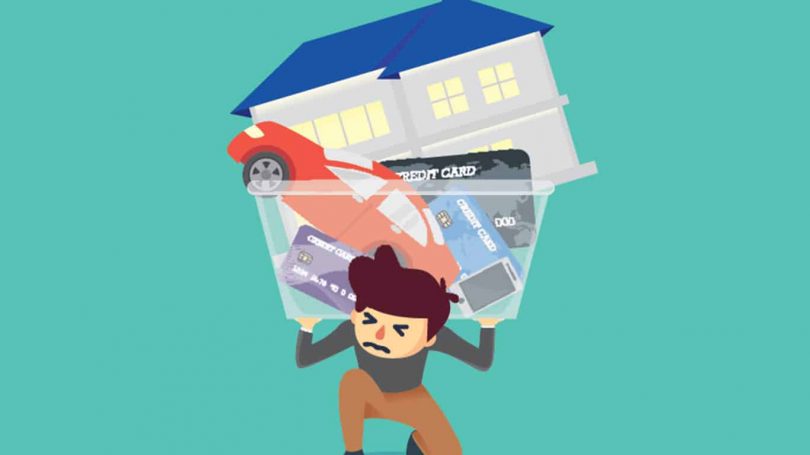There’s no doubt that most Americans love their plastic.
Because many credit cards have low barriers to entry, they are often an easy way to obtain a credit line and build credit. So credit cards are considered a good tool for beginners to use when building their credit history. Additionally, if used responsibly, credit cards can be an important part of building a credit history.
But unfortunately, many people struggle to pay off balances.
More than 60% of U.S. adults had a credit card in 2019, according to Experian. And among households with revolving credit card debt, the average balance was more than $6,800, costing about $1,160 in annual interest, according to a 2019 survey.
Although carrying the balance isn’t necessarily an issue, not paying it off every month may cause interest accrual that can make a balance more challenging to pay off.
So, if you’re like the millions of Americans who carry a credit card balance every month, understanding the effects can help you determine how to reduce your credit card debt.
The Upshot on Carrying a Balance
In addition to remaining in the debt cycle, there are other financial consequences of carrying a balance on a credit card. Here are a couple of things you can expect when you don’t pay your balance off every month.
Effect on Credit Score
Carrying a high balance on a credit card relative to its credit limit could lower your credit score because it increases the credit utilization ratio, or balance-to-limit ratio, which shows the amount of available credit a person has.
To calculate your ratio, divide your total credit card balances by your total available credit. Ideally, you want to keep your credit utilization ratio under 30%. When you exceed this percentage, your credit scores may decrease a lot faster.
Borrowers trying to decrease their credit utilization should know that it can take two or three credit statement cycles for credit utilization levels to decrease when debt is being paid off.
Accrued Interest
Credit card users who don’t pay off balances every month accrue interest based on the annual percentage rate specified in the credit card terms.
The rate is the approximate interest paid on any balance that’s not paid off when the credit card bill is due, plus any fees. While APRs vary across credit cards and depend on credit history, the average credit card APR ranges from around 13% to 23%.
Most credit cards charge compounding interest. In simple terms, this means that credit card users with a balance that’s carried over from billing cycle to billing cycle end up paying interest on the interest that accrued.
Therefore, if they don’t pay off the balance every month, interest continues to accumulate and is tacked on to the balance.
The majority of credit cards compound interest daily. Therefore, if anything is owed after the payment due date, the balance can easily start climbing.
You can use a credit card interest calculator to get an estimate of how much interest has added to your balance. It might come as a surprise.
Reducing Credit Card Debt
Repaying credit card debt can seem like an uphill battle. But fortunately, with planning, commitment, and tools, it can be achieved. While it might not be an easy feat, taking small steps can help to chip away at credit card debt.
Here are a few options to tackle debt.
Budgeting to Repay Credit Card Debt
No matter how much credit card debt you have, you may want to start with revamping your budget. If you don’t already have one, this is the perfect time to create one. You’ll want to make a list of your monthly expenses and income.
You can record this information in a spreadsheet or a budgeting app, whichever makes it easier to track expenditures.
Once you have a list of the money you have coming in and going out, identify areas where you might be able to cut back on your spending habits. For example, do you find yourself overspending on clothes or eating out more often than not? Wherever you might be overspending, take this opportunity to eliminate some unnecessary expenses.No matter how much credit card debt you have, you may want to start with revamping your budget.
You may also want to incorporate a debt repayment strategy into your budget to accelerate the process. If you’re someone who is motivated by seeing fast results, you may want to consider the snowball method of repayment.
This strategy prioritizes paying off credit cards with the smallest balances first. Once you pay down the smallest balance, you move on to the second smallest balance, etc.
On the other hand, the avalanche approach could help you save more money in the future, because the goal is to repay credit card balances with the highest interest rates. Once you pay off the balance with the highest interest rate, you move on to the next highest interest rate, continuing until all debt is repaid (while making at least minimum payments on all other balances, of course).
Both debt repayment strategies have advantages and disadvantages, so you may want to consider which method you’ll be most able to stick with or use them as inspiration to create a plan that will work for you.
Opening a Balance Transfer Credit Card
Another option to consider is to open a balance transfer credit card. The idea is to open a new credit card with an introductory interest rate that is significantly lower than your current credit card interest rate. This can allow you to pay off your credit card balance at a lower rate as long as you pay it off in the introductory time frame.
You can potentially pay off your balance within a shorter time while saving money on interest. It’s important to note that the low-interest rate on balance transfer credit cards is usually only offered for an introductory period, usually between six and 18 months. Once that period expires, the rates typically increase.
If you plan to repay the balance before the introductory period ends, a balance transfer credit card might be worth pursuing. Make sure to account for a balance transfer fee – usually 3% to 5%.
As with any other credit card application, your credit history will determine if you qualify and what rate you’ll receive. If your credit isn’t ideal, this might not be an option.
Making Extra Payments
If you don’t want to open a new credit card, you can make extra payments to reduce interest costs. Again, credit card interest is calculated on the account’s daily average balance. Therefore, by making one or more extra payments throughout the month, you can lower the total interest accrued by the time your bill is due.
Even if you can only put a few extra dollars toward each payment, it can help minimize the interest cost.
Using a Personal Loan
If you have high-interest credit card debt, a debt consolidation loan can be an option worth considering. Consolidating all of your debts into a personal loan may help you streamline your finances.
SoFi® offers unsecured personal loans with low, fixed interest rates and fixed monthly payments, so borrowers may be able to save money and enjoy the ease of one predictable payment.
Checking your interest rate and terms will not affect your credit score. If the new rate and terms make sense for your financial situation, you can apply for a new loan with no fees, including no origination fees or late fees.
This article originally appeared on SoFi.
Disclaimer: Many factors affect your credit scores and the interest rates you may receive. SoFi is not a Credit Repair Organization as defined under federal or state law, including the Credit Repair Organizations Act. SoFi does not provide “credit repair” services or advice or assistance regarding “rebuilding” or “improving” your credit record, credit history, or credit rating. For details, see the FTC’s website.








